SERVICE MANUAL UPDATE SEC.6E3 REVISED CODE 41 DIAG. CHART

SUBJECT: SERVICE MANUAL UPDATE - REVISED CODE 41 /E041 CHART, FACING PAGE
MODELS/YEARS: 1988-91 TORONADO, NINETY-EIGHT, EIGHT-EIGHT - WITH 3800 (VIN C, L)
This bulletin updates the following:
MANUAL/PAGE ------------ 1991 Ninety-Eight pages 6E3-A-74 and 6E3-A-75. 1991 Toronado/Trofeo pages 6E3-A-74 and 6E3-A-75.
o The Code 41 Diagnostic Chart in the "Driveability And Emissions" Section on page 6E3-A-75 for 1991 Ninety-Eight, Toronado and Trofeo models equipped with the 3800 (VIN L) engine. Separate charts are included for "Type 1" and "Type 11" ignition systems. See bulletin page 2 for "Type 1" and page 3 for "Type 11". Be sure to use the correct chart for the system being diagnosed.
MANUAL/PAGE ------------ 1988-89 Eighty-Eight/Ninety-Eight pages 6E3-A-68 and 6E3-A-69. 1990 Eight-Eight/Ninety-Eight and 1991 Eighty-Eight pages 6E3-A-70 and 6E3-A-71.
o The code 41 Diagnostic Chart and Facing Page in the "Driveability And Emissions" Section 6E3 for 1988-91 Eighty-Eight and 1988-90 Ninety-Eight models equipped with the 3800 (VIN C) engine. Refer to bulletin page number 5 for the chart and page 4 for the facing page.
MANUAL/PAGE ----------- 1988 and 1990 Toronado/Trofeo pages 8Dl -50 and 8Dl -51. 1989 Toronado/Trofeo pages 8Dl -52 and 8Dl -53.
o The Code E041 Diagnostic Chart and Facing Page in the "ECM Trouble Code Diagnosis" Section 8Dl for 1988-90 Toronado and Trofeo models equipped with 3800 (VIN C) engine. Refer to bulletin page 5 for the chart and page 6 for the facing page.
This revised Service Manual information addresses the possibility of a faulty ignition module causing Code 41 /E041 to be set by not supplying the CAM sensor signal to the ECM/PCM.
Please note these corrections on the appropriate pages of the affected Service Manuals.
CODE 41 CAM SENSOR CIRCUIT 3800 (VIN C) (PORT)
Circuit Description:
The 3800 engine uses the simultaneous mode of fuel injection during start-up. As engine speed attains the 400 rpm level and a cam signal has been received by the ECM from the C31 module, the fuel injection switches modes to sequential injection. This is accomplished by use of a cam interrupter magnet and a cam sensor "hall effect" switch. The cam sensor sends a signal (sync-pulse) to the ignition module when cylinder #1 is 25 degrees after top dead center on the compression stroke. This signal is used to start sequential fuel injection with the proper cylinder. If the cam signal is lost to the ECM, the engines fuel delivery will switch back to the simultaneous mode of operations. THE ENGINE WILL CONTINUE TO RUN. IT WILL RESTART AFTER SHUT DOWN.
Code 41 is set when the following conditions are met. o Engine is running. o Cam sensor signal not received by ECM for last 2 seconds.
Test Description: Numbers below refer to circled numbers on the diagnostic ----------------- chart.
1. This step verifies proper operation of CKTs 633, 644, and 645. 2. Step verifies the integrity of CKT 630 from Ignition module to ECM. 3. If the camshaft gear magnet is interfacing with the cam sensor the voltage reading will be zero, bumping engine will cause the condition to away. 4. If the voltage reading of "BC5" is constantly varying and connection to the ECM is good, the ECM is faulty.
Diagnostic Aids:
An intermittent may be caused by a poor connection, rubbed through wire insulation or a wire broken inside the insulation.
Check For:
o Poor Connection or Damaged Harness Inspect ECM harness connectors for backed out terminal "BC5", improper mating, broken locks, improperly formed or damaged terminals, poor terminal to wire connection and damaged harness.
o Intermittent Test If connections and harness check OK, monitor a digital voltmeter connected from ECM terminal "BC5" to ground while moving related connectors and wiring harness. If the failure is induced, the voltage reading will change. This may help to isolate the location of the malfunction.
CODE E041 CAM SENSOR CIRCUIT 3800 (VIN C) (PORT)
Circuit Description:
During cranking, the ignition module monitors the dual crank sensor sync signal. The sync signal is used to determine the correct cylinder pair to spark first. After the sync signal has been processed by the ignition module it sends a fuel control reference pulse to the ECM. When the ECM receives this pulse it will command all six injectors to open for one priming shot of fuel in all cylinders. After the priming, the injectors are left off for the the next six fuel control reference pulses from the ignition module (two crankshaft revolutions). This allows each cylinder a chance to use the fuel from the priming shot. During this waiting period, a cam pulse will have been received by the ECM. Now the ECM begins to operate the injectors sequentially based on true camshaft position. However, if the cam signal is not present at start-up, a Code E041 will set and the ECM will start sequential fuel delivery in random pattern with a 1 in 6 chance that fuel delivery is correct.
Code E041 is set when the following conditions are met: o Engine is running. o Cam sensor signal not received by ECM for last 2 seconds.
Test Description: Numbers below refer to circled numbers on the diagnostic ---------------- chart.
1. This step verifies proper operation of CKTs 633, 644, and 645. 2. Step validates the integrity of CKT 630 from the ignition module to ECM. 3. If the camshaft gear magnet is interfacing with the cam sensor the voltage reading will be zero, bumping engine will cause the condition to go away. 4. If the voltage reading of "BC5" is constantly varying and connection to terminal "BC5" are good, the ECM is faulty.
Diagnostic Aids:
An intermittent may be caused by a poor connection, rubbed through wire insulation or a wire broken inside the insulation. Check For:
o Poor Connection or Damaged Harness Inspect ECM harness connectors for backed out terminal "BC5", improper mating, broken locks, improperly formed or damaged terminals, poor terminal to wire connection and damaged harness.
o Intermittent Test If connections and harness check OK, monitor a digital voltmeter connected from ECM terminal "BC5" to ground while moving related connectors and wiring harness. If the failure is induced, the voltage reading will change. This may help to isolate the location of the malfunction.
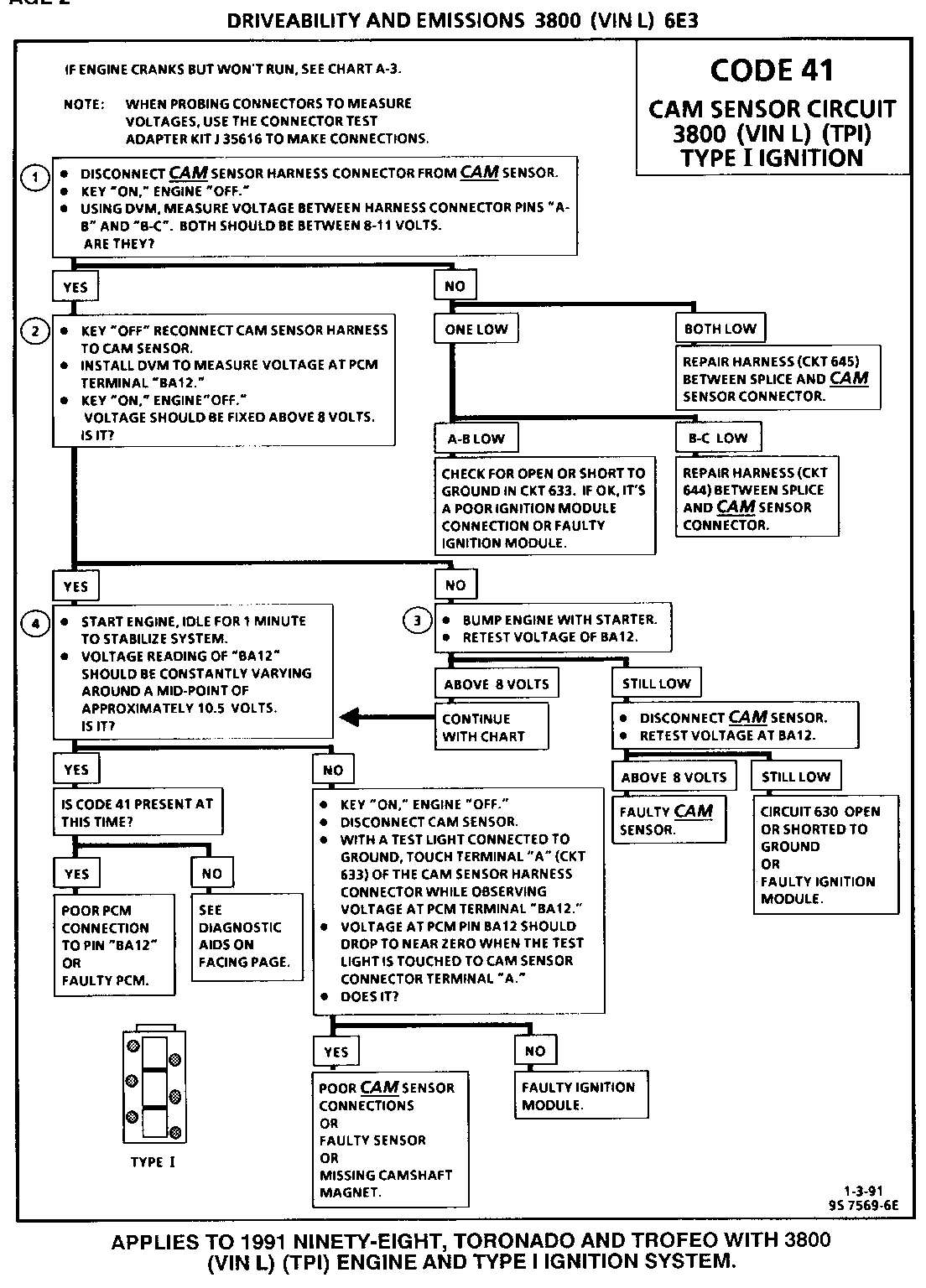
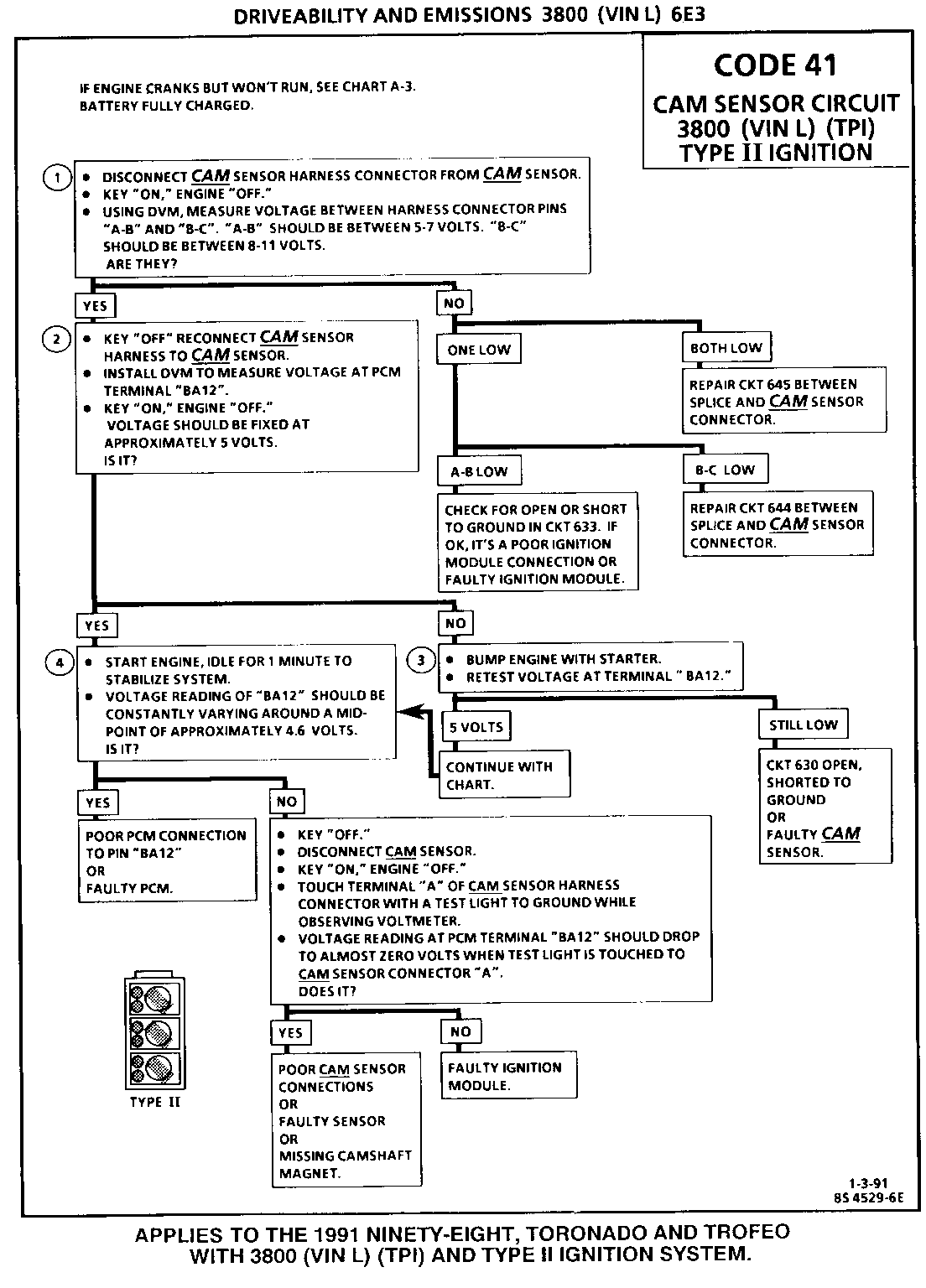
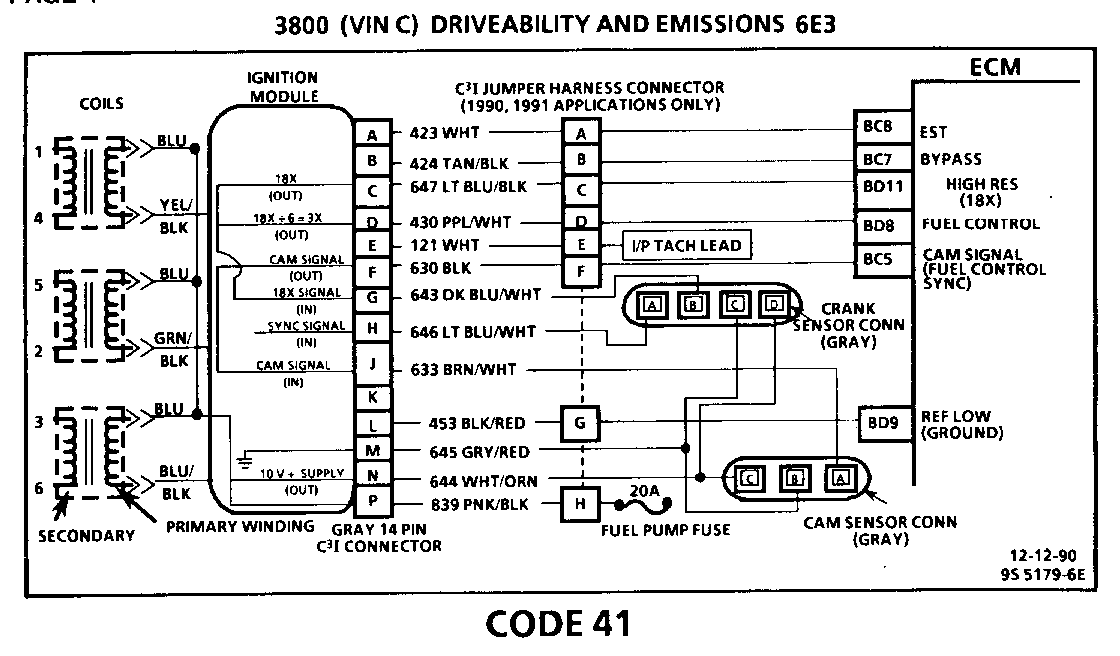
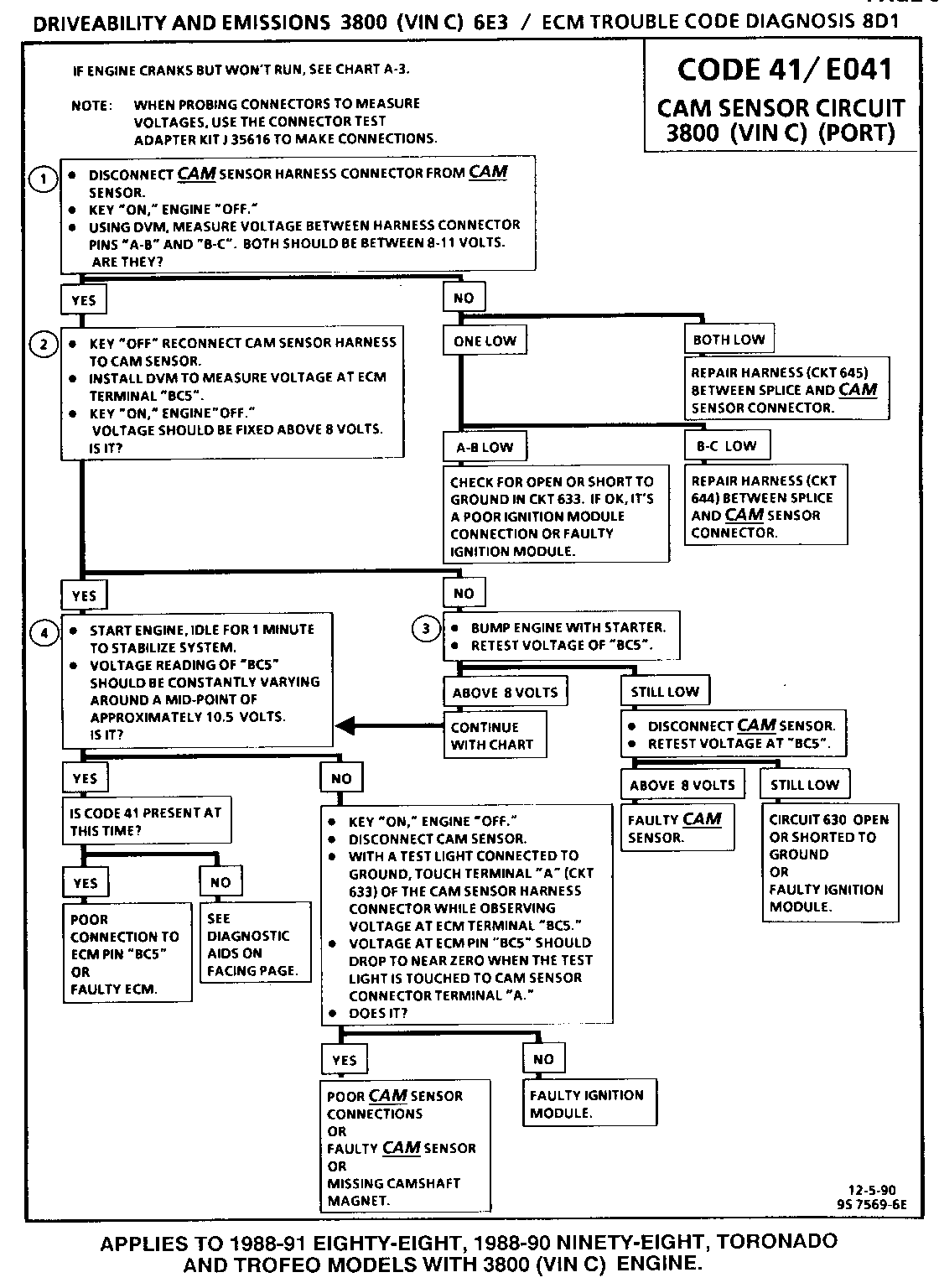
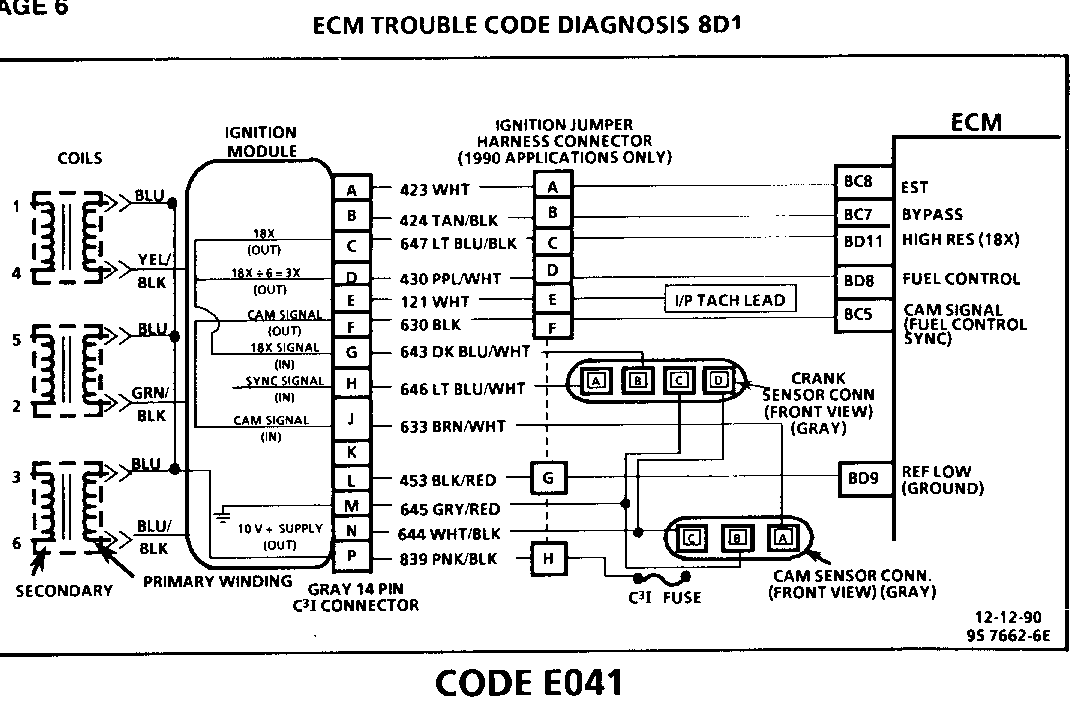
General Motors bulletins are intended for use by professional technicians, not a "do-it-yourselfer". They are written to inform those technicians of conditions that may occur on some vehicles, or to provide information that could assist in the proper service of a vehicle. Properly trained technicians have the equipment, tools, safety instructions and know-how to do a job properly and safely. If a condition is described, do not assume that the bulletin applies to your vehicle, or that your vehicle will have that condition. See a General Motors dealer servicing your brand of General Motors vehicle for information on whether your vehicle may benefit from the information.
